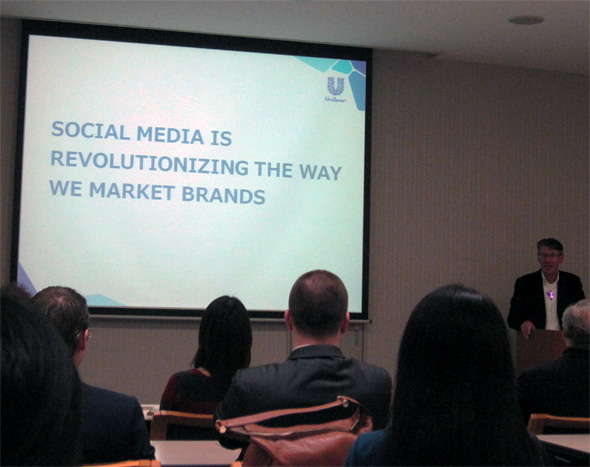Ray Bremner, President & CEO of Unilever Japan gave a talk at Waseda University
From Advertising to consumers to mattering to people
My key take-away is that social media have made the top-down “begin told” way of advertising obsolete, and replaced it by finding, sharing and engaging.
About Unilever:
- Unilever was founded in 1929 by the merger of the British soap maker “Lever Brothers” (founded in 1885 by William Hesketh Lever, The Right Honourable The Viscount of Leverhulme), with the Dutch margarine producer “Naamloze Vennootschap Margarine Uni”, which was formed by the merger of several margarine companies, including those of Antonius Johannes Jurgens and Samuel van den Bergh. Soap brought hygiene to ordinary people, and margarine helped people who could not afford butter. Both companies, Lever and Margarine Uni had in common that they used palm oil as raw material.
- The merger of Lever and Margarine Uni was decided over dinner in London in 1929, and written down in a 100 word merger agreement – unthinkable today for an M&A agreement.
- About 50% of Japanese people have Unilever products at home
- Unilever vision 2010 is: double the business, while reducing the environmental footprint. Execution of this vision is measured by 60 KPIs and the results are published.
- Unilever vision:
- We work to create a better future every day.
- We help people feel good, look good, and get more out of life with brands and services that are good for them and good for others. We will inspire people to take small everyday actions that can add up to a big difference for the world.
- We will develop new ways of doing business that will allow us to double the size of our company while reducing our environmental impact.
- Unilever mission: building brands that improve people’s lives.

Ray Bremner: “social media are revolutionizing the way we market brands, and they are making people like me extinct”.
From 2001 to 2013, the average time Japanese consumers spend watching TV has decreased from about 3 1/2 hours/day to 3 hours/day, while the time spent with PC & mobile has tripled from 1/2 hour/day to 1 1/2 hours per day. Most Japanese age groups use social media, usage peaks at 35% for men in their 20s, and around 45% for women in their 20s, and around 30% in their 30s.
TV reaches about 88% of Japan’s population, and digital media (PC and mobile) reach about 73%.
From 2001 to 2012, advertising expenditure in Japan has decreased from about US$ 27 Billion/year to US$ 23 Billion/year, while expenditure for digital media has increased from zero to US$ 12 Billion/year. For an overview of Japan’s media markets – see “Japan’s Media“.
How to make marketing messages a pleasure rather than annoying?
How do we succeed? Crafting brands for life.
- Put people first, not just consumers. Real people with real lives.
- Build brand love.
- Unlock the magic.
The brand love triangle
How do you create a conversation people want to participate in?
We use the “brand love triangle. “The people we serve” are in the center. The three edges of the brand love triangle are:
- Purpose (brand point-of-view) <— brand history dive
- Product truth <— product dive
- Human truth <— people immersion

“Dove Real Beauty Sketches” by Steve Miles
Brands need a purpose, a point of view. Before 2002 Dove did not have a purpose.
Steve Miles talking about Dove and himself:
93% of women do not think they are beautiful – men are opposite: 93% of men think that they look just great. Dave Miles (and Dove’s) point of view is that everyone is beautiful. This point of view is expressed in “Dove Real Beauty Sketches”, which won the Titanium Grand Prize and 10 Gold Lions at Cannes 2013:
As of today, “Dove Real Beauty Sketches” has 61,767,827 views on YouTube, which is not as much as PSY’s Gangnam Style with 1,888,086,686 views, but still – pretty amazing.
Another example of brand communication is Harley Davidson, which signifies “Freedom of the Road”, independent character. Harley Davidson creates a bond to customers by presenting each customer with the “umbilical cord”, the belt with which the Harley Davidson motor bicycle was tied down during the transport from the factory to the customer.
Focus: In 2000, Unilever had 1600 brands and today 400 brands.
Q&A
Question: How many of your campaigns in Japan are global campaigns? How many are Japan-only?
Answer: practically all campaigns for all international brands of any company are made in Japan for Japan. That is not to say that global ideas do not work. In fact in most cases International Brands have the same brand and advertising positioning in Japan as elsewhere in the world. What does differ for Japan is that often Japanese consumers have different usage habits, have different views about the world and the cues within the advertising can leave different impressions on Japanese minds. The Japanese consumer is highly observant of small details in advertising ; much more so than the average European for example.
That means that we test Global campaigns but very often we have to create Japan only executions so that how we express the idea is done totally with the Japanese consumer in mind. This is more costly and time consuming but essential for success.
Copyright (c) 2014 Eurotechnology Japan KK All Rights Reserved


join the discussions